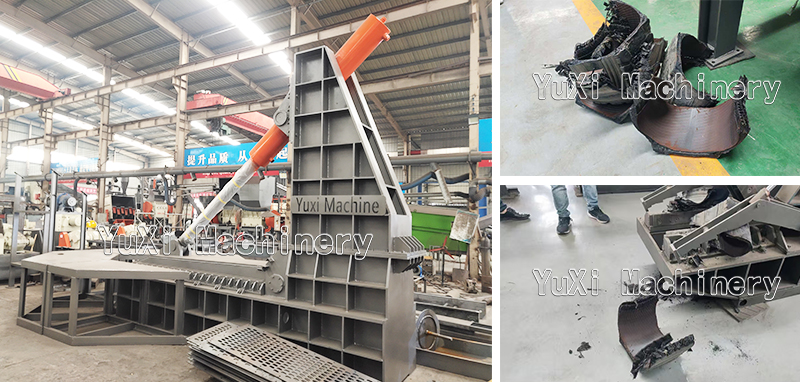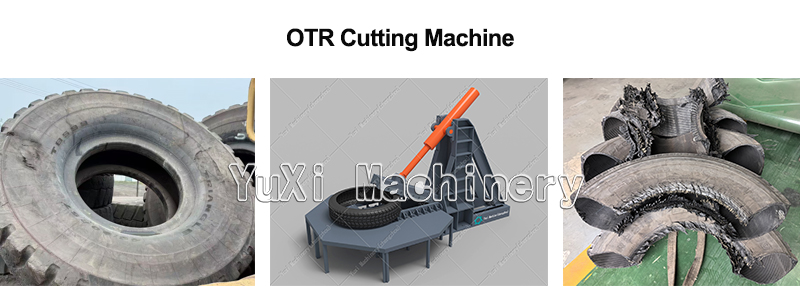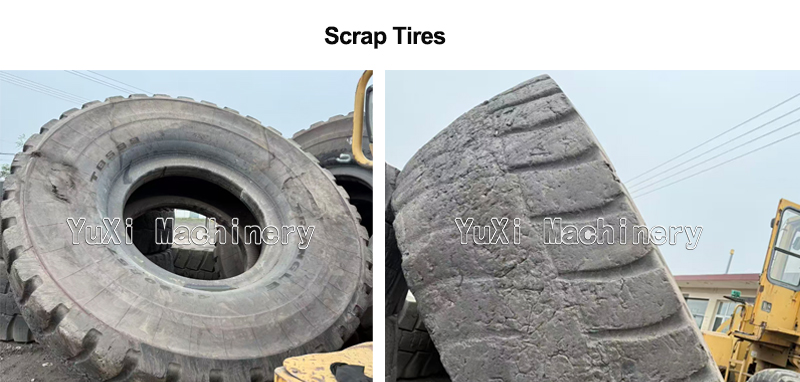At the front end of a waste tire recycling production line, there’s always one piece of equipment that takes on the “toughest first task” — it’s the waste tire cutting machine. When faced with giant tires (weighing hundreds of kilograms) from trucks or excavators, ordinary equipment can’t even start. But the tire cutting machine acts like a “preoperative scalpel,” precisely slicing these “bulky pieces” into neat chunks, paving the way for subsequent crushing and separation processes. Today, we’ll take an in-depth look at this “pioneer” of the tire recycling chain.
A waste tire cutting machine is an indispensable pre-processing device in tire recycling production lines — its core mission is to solve the pain point of “giant tires being impossible to process directly.” Large, high-strength tires (such as all-steel radial truck tires or excavator tires) are bulky, thick with rubber, and densely embedded with steel wires. Throwing them directly into a crusher would not only jam the equipment but also reduce the efficiency of the entire line.
The role of the tire cutting machine is to use powerful cutting to turn these “tough nuts” into neat strips or chunks, allowing subsequent crushing and wire-drawing equipment to operate smoothly. Ultimately, this boosts the efficiency and stability of the entire recycling line. Simply put: without it, giant waste tires can’t even “enter the door” of the recycling production line.

Tire cutting machines are custom-built for “large, high-strength waste tires.” Their processing targets are all the “hard cases” that ordinary equipment dares not touch:
In short: Any tire that is “too large, too hard, or uncuttable by ordinary equipment” is its “target customer.”
The core power of a tire cutting machine is its hydraulic system (equipped with a 100HP motor). Leveraging the extreme force of high-pressure hydraulics, it “holds the giant tire in place and cuts it.” Its workflow is simple but powerful, and fully automated:
1.Loading + Positioning: “Place” the Giant Tire on the Workbench
The operator lays the entire giant tire flat on the equipment’s feeding platform — no additional fixing is needed, as the equipment automatically completes subsequent positioning calibration to ensure the tire doesn’t shift during cutting.
2.Hydraulic Clamping: “Lock” the Tire to the Platform
When the equipment starts, a high-power hydraulic cylinder drives the clamping arm to tighten quickly, securing the tire like a “steel vice” (with a clamping force of up to 150kN). This step is critical for safety and cutting precision: if a hundreds-of-kilogram tire wobbles during cutting, it will not only result in uneven cuts but also pose safety risks.
3.Powerful Cutting: Slice in One Go with an “Industrial Scissors”
The hydraulic system drives an ultra-heavy cutting disc (made of AISI 4140 alloy steel) to descend vertically, exerting enormous shearing force — even all-steel tires filled with steel wires can be “cleanly and efficiently cut in one go.” The cutting disc’s descent speed and pressure are precisely controlled to ensure smooth cuts without damaging the equipment due to excessive force.
4.Unloading: Cut Chunks Go Straight to the Next Process
After cutting, the clamping device releases automatically. The cut tire strips/chunks slide off the platform and are directly fed into the subsequent crusher — the entire process, from loading to unloading, requires almost no manual intervention. This saves time and reduces the operator’s labor intensity.

Tire cutting machines can handle giant tires thanks to these 3 “hard strengths”:
1.Extreme Shearing Force: Cut Through Both Steel Wires and Rubber
Its hydraulic system delivers sufficient power, outputting 200kN of shearing force — even thick steel wires in all-steel radial tires can be cut directly, with no “jamming” or “incomplete cutting.”
2.Durable Cutting Components: Handle “Tough Materials” Repeatedly
The cutting blade is made of AISI 4140 special alloy steel, treated with quenching and tempering (hardness HRC 48-52), so its hardness and wear resistance far exceed ordinary steel. Even with long-term cutting of steel-wire tires, it remains sharp, with a service life 4-6 times longer than ordinary cutting components.
3.Safety + Automation: Peace of Mind and Convenience
The equipment is equipped with a hydraulic locking system + safety electronic control system: if anomalies are detected (e.g., loose clamping, operator error), it stops immediately. Meanwhile, the fully automated operation means the operator only needs to load the tire, with no need to approach the cutting area — greatly reducing safety risks.
In Europe and the U.S., the use of tire cutting machines must meet strict environmental and safety requirements:
The implementation of these standards makes the tire cutting machine not just an “efficiency tool,” but also a “compliant device” — it ensures the pre-processing of giant waste tires fully meets the environmental and safety regulations of the European and American recycling industries.

In the tire recycling industry chain, the tire cutting machine acts as the “efficiency gatekeeper”:
Now, as the number of construction vehicles and heavy trucks grows, the demand for recycling giant waste tires is increasing — tire cutting machines are also constantly upgrading: larger feeding platforms, more powerful hydraulic systems, smarter cutting controls, and even the ability to automatically adjust cutting parameters based on tire size.
From “unprocessable giant waste” to “neat chunks ready for the recycling chain,” the tire cutting machine is the “key driver” of this transformation. Next time you see a waste tire from a heavy truck, you might think: in some recycling factory, a cutting machine is turning it into a “usable resource material.”